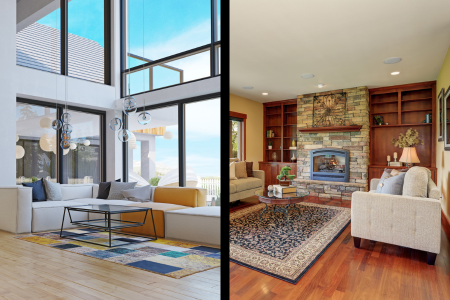Choosing between a modern or traditional renovation style is a significant decision when remodeling a home. Both styles offer unique benefits, aesthetics, and functionality that cater to different preferences and lifestyles. Understanding the defining characteristics of each approach helps homeowners create a space that aligns with their vision. Here is how to determine which renovation style best fits your home.
Understanding Modern Renovation Style
Modern renovations emphasize simplicity, efficiency, and contemporary design elements. Clean lines, open spaces, and minimalistic decor define this aesthetic. Neutral color palettes, sleek materials, and functional layouts enhance a modern look, creating an uncluttered and sophisticated atmosphere.
Technological integration is a key feature of modern homes, with smart systems controlling lighting, security, and temperature. Floor-to-ceiling windows, glass partitions, and natural lighting contribute to an airy ambiance, maximizing openness and space utilization.
Furniture and decor in modern homes focus on streamlined designs with geometric shapes, metal finishes, and smooth surfaces. Kitchens and bathrooms often feature quartz countertops, stainless steel appliances, and handle-free cabinetry, reinforcing a sleek and minimalist appeal.
Understanding Traditional Renovation Style
Traditional renovations focus on warmth, character, and timeless elegance. Rich woodwork, detailed moldings, and classic furniture styles contribute to a cozy and inviting atmosphere. Ornate fixtures, vintage decor, and intricate designs highlight craftsmanship and heritage.
Traditional homes often feature warm color schemes with deep tones, soft pastels, and decorative accents. Natural materials such as hardwood floors, stone fireplaces, and detailed cabinetry emphasize authenticity and sophistication.
Furniture and decor embrace refined aesthetics, including tufted sofas, carved wood details, and antique-inspired elements. Kitchens and bathrooms in traditional homes feature decorative backsplashes, farmhouse sinks, and vintage-style lighting, adding charm and personality.
Key Differences Between Modern and Traditional Renovation Styles
- Design Approach: Modern style favors minimalism and functionality, whereas traditional design embraces intricate details and classic artistry.
- Materials Used: Modern renovations incorporate steel, glass, and engineered surfaces, while traditional renovations rely on wood, stone, and handcrafted features.
- Color Palettes: Neutral, monochrome tones define modern spaces, whereas warm, rich hues characterize traditional interiors.
- Furniture Styles: Modern furniture is sleek and geometric, while traditional furniture includes elegant curves, detailed upholstery, and vintage influences.
- Lighting Concepts: Modern homes utilize recessed lighting and large windows, while traditional homes incorporate chandeliers, sconces, and ambient lighting.
How to Choose the Right Style for Your Home
Selecting the ideal renovation style depends on personal preference, architectural compatibility, and long-term functionality. Consider your lifestyle needs and the atmosphere you wish to create.
If you prefer a clutter-free, streamlined space with high-tech conveniences, a modern renovation suits your needs. Homes with contemporary layouts, open floor plans, and updated structures benefit from modern styling.
If warmth, nostalgia, and decorative elements appeal to you, a traditional renovation may be the better option. Historical homes, rustic properties, and houses with rich architectural details align naturally with traditional aesthetics.
Blending both styles is another approach, integrating modern efficiency with traditional comfort. A transitional renovation combines sleek surfaces with classic materials, achieving balance between contemporary and timeless elements.
Conclusion
Both modern and traditional home renovation styles bring distinctive charm and functionality to a home. Modern renovations prioritize sleekness and innovation, while traditional designs highlight elegance and history. Understanding the key differences and aligning them with personal preferences ensures a well-executed renovation that enhances both aesthetics and comfort.

